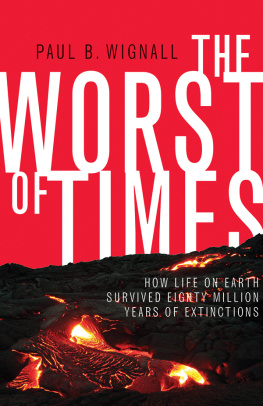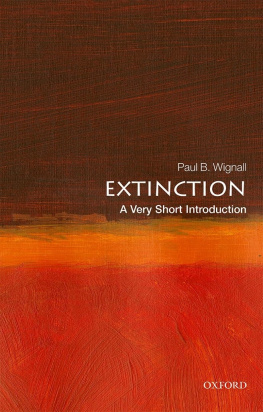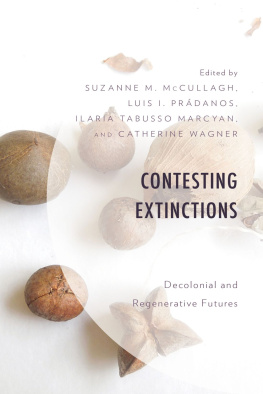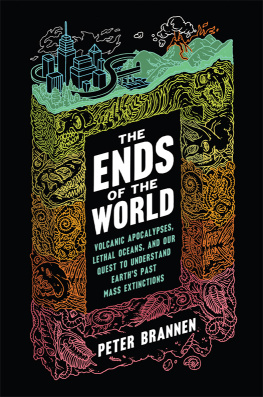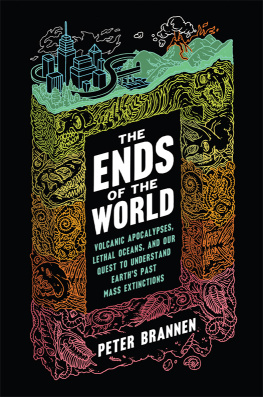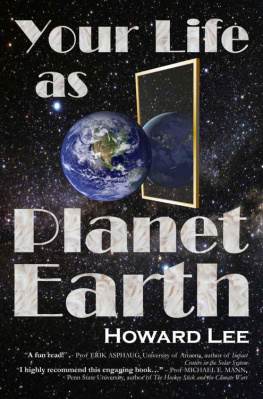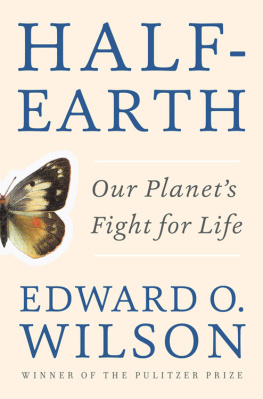
THE WORST OF TIMES
THE WORST OF TIMES
HOW LIFE ON EARTH SURVIVED EIGHTY MILLION YEARS OF EXTINCTIONS
PAUL B.WIGNALL
PRINCETON UNIVERSITY PRESS
Princeton and Oxford
Copyright 2015 by Princeton University Press
Published by Princeton University Press, 41 William Street, Princeton, New Jersey 08540
In the United Kingdom: Princeton University Press, 6 Oxford Street, Woodstock, Oxfordshire OX20 1TR
press.princeton.edu
Cover art Dai Mar Tamarack/Shutterstock.
All Rights Reserved
Second printing, and first paperback printing, 2017
Paperback ISBN 978-0-691-17602-4
The Library of Congress has cataloged the cloth edition of this book as follows
Wignall, P. B.
The worst of times : how life on earth survived eighty million years of extinctions / Paul B. Wignall.
pagescm
Includes bibliographical references and index.
ISBN 978-0-691-14209-8 (hardcover : alk. paper) 1. Mass extinctions. 2. Extinction (Biology) 3. Survival. I. Title.
QE721.2.E97W542016
576.84dc23
2015005727
British Library Cataloging-in-Publication Data is available
This book has been composed in Sabon Next LT Pro & Grotesque MT STD.
Printed on acid-free paper.
Printed in the United States of America
10 9 8 7 6 5 4 3 2
FOR KAREN
CONTENTS
ILLUSTRATIONS
FIGURES
PLATES
Plates follow page 108.
ACKNOWLEDGMENTS
This volume is the product of a quarter century spent trying to unravel what happened during the greatest series of catastrophes in the history of life. I originally started looking at the worst of them all, the Permo-Triassic mass extinction, because its sheer scale was awe inspiring but also, more prosaically, because the most famous mass extinction of the day, the one that killed the dinosaurs, was being intensively investigated. It would have been hard for a newly fledged geologist like myself to muscle into an already crowded field. Gradually the Permo-Triassic mass extinction has become the go-to disaster for extinction workers, and I have found myself drawn to study other examples, some of which had not even been discovered twenty-five years ago. Each is unique but they are all fascinating because they all share many attributes; it began to seem that when the world goes to hell, it does so in very similar ways. And so was born the idea for this book. Mass extinctions require a certain set of ingredients and when everything is just right, in an evil Goldilocks kind of way, a disaster will surely follow.
My initial research was in the company of Tony Hallam, my former PhD supervisor and long-term friend and collaborator. Even at that stage Tony already knew a thing or two about mass extinctions, having contributed to the debates about the downfall of the dinosaurs at the end of the Cretaceous. He had also single-handedly pioneered research on an earlier mass extinction 200 million years ago, at the end of the Triassic, a crisis that has only become trendy within the last decade. Our initial collaborations required us to visit the far-flung locations where Triassic rocks can be seen lying on Permian ones.
China turned out to be a key country for studying many of the mass extinctions discussed in this book, and right from the start Tony and I were fortunate to get expert guidance from Yin Hongfu and his student Lai Xulong of the China University of Geosciences in Wuhan. Hongfu has since retired but continues to produce influential research, as does Xulong, who has risen to a high position in Wuhan University and built a large research school. His research students have included Sun Yadong, Song Haijun, Jiang Haishui, Wang Lina, and Luo Genming, who have all become my valued and influential collaborators.
Having been appointed at Leeds University, I was able to build my own teams of extinction hunters including (in chronological order, oldest first) the following PhD studentsRichard Twitchett, Rob Newton, David Bond, Eleanor John, James Witts, and Luke Faggettertogether with that rare breed of scientist, the postdoctoral research fellow: Stphanie Vdrine, Alex Dunhill, and Juan Carlos da Silva. I have enjoyed being able to share the many highs and lows of research with them all while of course allowing them do a lot of the hard work.
I would also like to thank colleagues and friends from around the world, some sadly no longer with us, who have shared my fascination with geological calamities and provided ideas, conversations, and different perspectives and have generally enlivened the already enjoyable life of a geologist: Thierry Adatte, Derek Ager, Tom Algeo, Jason Ali, Mike Benton, Dave Bottjer, Pat Brenchley, Mike Brookfield, Matthew Clapham, Jacopo dal Corso, Steve Grasby, Janos Haas, Steve Hesselbo, Jason Hilton, Yukio Isozaki, Dougal Jerram, Michael Joachmiski, Gerta Keller, Heinz Kozur, Kiyoko Kuwahara, Cris Little, Cindy Looy, John McArthur, Jenny McElwain, Jared Morrow, Jonathan Payne, Jeff Peakall, Nereo Preto, Sara Pruss, Greg Racki, Sylvain Richoz, Alastair Ruffell, Ivan Savov, Dolf Seilacher, Mark Sephton, Jack Sepkoski, Sha Jingeng, Mike Simms, Bas van de Schootbrugge, Wang Wei, Mike Widdowson, and Henk Visscher.
Special thanks go to David Bond and Rob Newton, both excellent, multitalented research scientists and valued companions on many a field trip; we have spent many air miles together and a lot of time at Schiphol!
Last, I thank Jonathan Payne and a kind but anonymous reviewer of the original manuscript and especially Alison Kalett of Princeton University Press for sage advice and keeping me on topic during the many iterations of the pages that follow.
PROLOGUE
The public perception of mass extinctions is focused on the death of the dinosaurs, and for good reason. Stories do not get much more dramatic than the long reign of reptilian leviathans being abruptly terminated by a gigantic meteorite impact. However, this is not a book about that because, surprisingly, this was not the worst thing ever to happen to life. Bad though the dinosaur extinction was, something more devastating had happened nearly 200 million years earlier. The end of the Permian Period saw the loss of more than 90% of all species. Losses on this scale were soon recognized early in the study of geological history. More than 150 years ago, the English geologist John Phillips published a textbook, Life on Earth: Its Origin and Succession. It contained a chart documenting the ups and downs of the diversity of life that clearly showed major low points at the times that we now recognize as mass extinctions: at the end of the Cretaceous and the end of the Permian. But by the mid-nineteenth century, the idea that the history of life may record catastrophic events was not in vogue. Catastrophism had had its day; championed by Georges Cuvier in the earlier part of the century, it had been replaced by a uniformitarian view that changes were slow and gradual.
All this changed with the publication of a paper in 1980 that provided excellent evidence for an instantaneous cataclysm at the end of the Cretaceous. The scientists involved, led by the father-and-son team of Luis and Walter Alvarez, showed that sediments at the level of the mass extinction had high concentrations of iridium, a metal that is rare in the Earths crust but more common in meteorites. Catastrophism was back on the agenda.
The 1980s saw a frenzy of activity on the Cretaceous-Tertiary mass extinction, which resulted in the discovery of the giant crater at Chicxulub, underlying the forests of the Yucatan Peninsula. Gradually geologists also began to turn their attention to other mass extinctions to see if they too were caused by impacts. Thus, the Permo-Triassic mass extinction finally began to receive some long-overdue attention. Eventually, tentative evidence for an impact at this time began to be found: a few grains of quartz that may or may not have been formed under high pressure at the impact site, rare traces of carbon molecules that allegedly could only be formed during impact, etc. None of this is convincing. In fact, the true culprit had long been staring geologists in the face, at least those geologists who had visited northern Siberia. The Siberian Traps record a scale of volcanism that is unparalleled in modern times, and by the early 1990s it became apparent that they had erupted at precisely the right time to be implicated in the Permo-Triassic mass extinction. As it happens, similar gigantic lava fields were also erupted during the Cretaceous-Tertiary extinction in the Deccan region of India. The addition of another volcanism-extinction link started to look like a pattern was emerging. And so it has proved.
Next page
